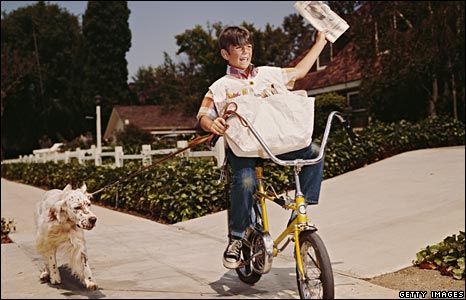Entries in wind farm agreement (12)
9/19/10 What part of 'conflict-of-interest' don't you understand?
Note from the BPWI Research Nerd: The story below outlines a problem that comes with wind development everywhere, including Wisconsin, where wind projects have been approved and permitted by members of local government who stood to gain financially from the project or had family members who would.
Although some members of the Wind Siting Council saw the conflict of interest issue as a problem that should be directly addressed in the wind siting rules, the majority of the council-- most of whom happen to have a direct or indirect financial interest in the outcome of the rules-- decided against including it.
Records show area officials profit
from leases with turbine firms
SOURCE: Observer-Dispatch, www.uticaod.com
September 18,2010
By JENNIFER BOGDAN,
Twelve public officials who sat on county and town boards in Lewis County stand to make a combined $7.5 million from the region’s largest wind-turbine project, government disclosure forms show.
And numerous other officials in Herkimer County stand to profit as well from new projects there, although not to the same extent, records show.
The lease arrangements have raised questions among local residents and good-government experts about potential conflicts of interest as wind-turbine farms are approved.
One person who feels that way is Gordon Yancey of the town of Lowville, who used to have a clear view of the Adirondacks stretching as far as the eye could see from his property on the edge of the Tug Hill plateau.
But in 2006, the sprawling Lewis County landscape became home to the Maple Ridge wind farm – a group of 195 wind turbines towering 400 feet high over the once undeveloped landscape in Lowville, Martinsburg and Harrisburg. Those communities are located along state Route 12 about one hour north of Utica.
Now, Yancey said all he sees are the massive white towers obstructing his view. He blames lease agreements between wind developers and public officials, one of whom is his brother, Edward Yancey, who sat on the Harrisburg Zoning Board of Appeals.
Edward Yancey stands to benefit to the tune of up to $1 million over the lifetime of the agreement, according to disclosure forms filed with the state by Iberdrola Renewables and Horizon Wind Energy, which co-own the project.
“They made their sweetheart, backdoor deals long before anything was made public,” Gordon Yancey said. “Of course, the boards pushed everything through.”
Edward Yancey could not be reached.
Disclose or face fine
A 2008 mandate from the state Attorney General’s Office requires wind companies to disclose the nature and scope of any municipal officer’s financial interest in a wind project or risk facing fines of as much as $100,000.
No companies have been penalized to date, according to the state Attorney General’s Office.
“In order to avoid even the appearance of impropriety, we publically disclose any relationship with a municipal officer or their relative,” Iberdrola spokesman Paul Copleman said.
Lise Bang-Jensen, senior policy analyst for the Empire Center for New York State Policy, said any move towards increased government transparency is admirable, but making sense of conflicts is more complex than writing them down.
“If you have a role on both sides of a project, that’s a clear conflict of interest,” Bang-Jensen said. “Putting it on a piece of paper and disclosing it, doesn’t make it legal.”
Many of the officials listed on the disclosure forms – including Harrisburg Town Supervisor Stephen Bernet, who stands to make $1 million – did not return calls last week.
One of those listed on the disclosure forms is Roger Grace, a Planning Board member in Pinckney. Maple Ridge wind farm spreads across Lowville, Harrisburg and Martinsburg, but Grace, who stands to make as much as $20,000 from the project, still is required to disclose his role in a neighboring town.
He said his role isn’t a concern, and he believes those involved have acted appropriately.
“I think everyone’s done a phenomenal job,” Grace said. “It’s always a battle, though. People that got money love them, and people that didn’t get money hate them. That’s all.”
‘Not acting objectively’
The issue of lease agreements between public officials and wind developers is burgeoning in Herkimer County, where the Hardscrabble wind farm is slowly rising.
The Herkimer County towns of Fairfield and Norway will soon be home to 37 turbines – seven of which are already standing.
In that project, five officials stand to make as much as $85,000 from the turbines that are expected to be up and running by the end of the year.
“For any municipal officers or their relatives with whom we have a relationship, we specifically request that the officers recuse themselves from a decision or vote that would in any way affect the development of a project or affect how the municipality treats wind power,” said Copleman, the Iberdrola spokesman.
Yet six years ago, when the Hardscrabble project was nothing more than a vague concept, questions arose as to why Fairfield Planning Board member Harold Robinson was voting on wind issues while he had an agreement with the wind company aiming to come to town, according to O-D archives.
“The Town Board is not acting objectively,” Fairfield Planning Board Chairman Peter Fishbein complained in 2004. “The board needs to acknowledge there are people who are worried about this and at least hear their concerns.”
Robinson, who stands to make as much as $20,000 from a lease agreement, did not return calls last week.
‘Won’t like the looks of things’
Other wind projects are brewing across the Mohawk Valley, including a plan from NorthWind and Power to build a farm of eight to 12 turbines on Dry Hill in Litchfield.
In that development, some residents have questioned the role played in the process by Litchfield Supervisor Wayne Casler, He is a regional controller at Barrett Paving Materials, which owns more than 100 acres of land on the southern end of Dry Hill.
Wind developers have said the paving company’s land won’t be considered, but the company could be chosen to supply materials for the project if it’s approved.
From time to time in Lowville, Gordon Yancey hears rumblings of other wind farm in the works – like the one in Litchfield.
Each time, he said, he thinks back to the days before his business was surrounded by turbines. Oftentimes, the curious come knocking on his door to ask what his experience was like years before.
“What I tell people is ‘Educate yourselves because you can’t trust where anywhere else is coming from,’” Yancey said. “Ask every question you can. And when you do, you won’t like the looks of things either.”
9/6/10 What to expect when you're expecting wind farm construction
What should you know before you lease your land to a wind developer?
You should know you must consult an independent lawyer BEFORE YOU SIGN. You will need someone who can tell you how the contract says the lease holder can use your land before, during and after construction.
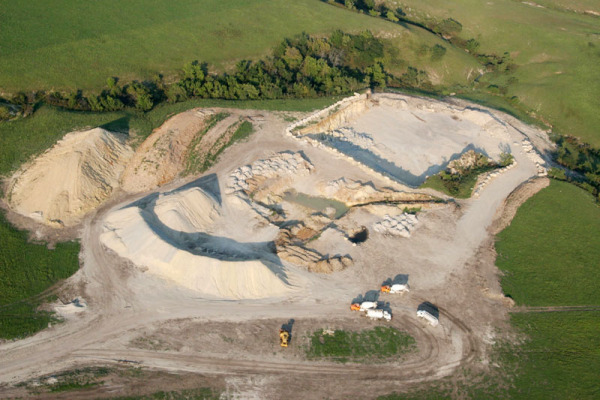
This picture shows the construction of a wind turbine project in Kansas.
Let's look closer..... 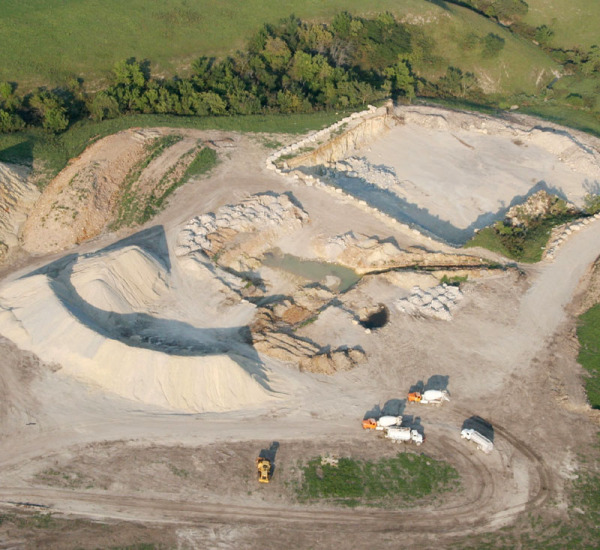
You should know how much of your land will be used during the construction phase and for how long, if you have any say at all in where the turbines will be sited, where the cables will be laid, and where the access roads will go. Only an independent lawyer can tell you what the contract says about this.
Look closer-
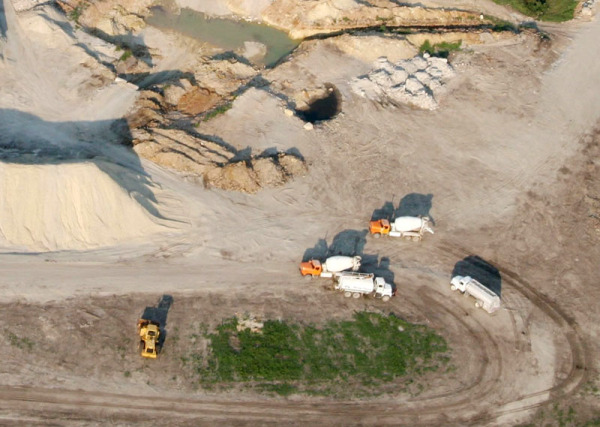
You should know that contracts may give the lease holder the right to go over, under, upon, along, and across your land, 24 hours a day, 7 days a week for the next 20 to 30 years. You should know what your rights are if changes, disputes or problems arise, and by what means problems may be resolved. An independent lawyer can tell you this.
Look closer..
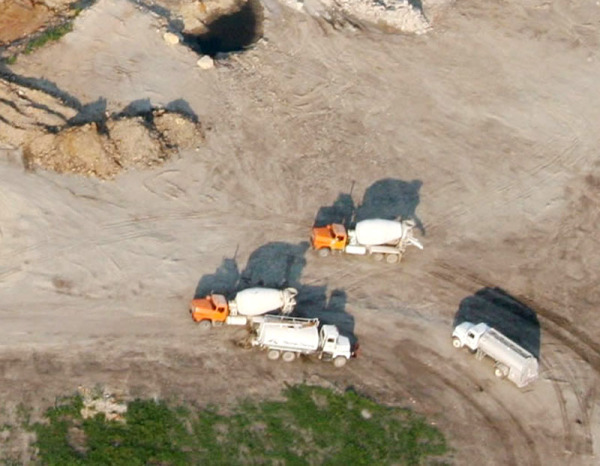
You should know that most lease agreements will be legally binding not just to you, but to your kids, any heirs, any future buyers, successors, executors, or assignees of any kind. You should know that most lease agreements require that ANYONE who owns the land after you or wishes to buy the land from you, will be also legally bound by the terms of this contract. Only an independent lawyer can tell you exactly what this means to the future of your property.

(To see more of this series of construction photos taken in Kansas, click here.)
9/1/10 Sow the wind turbine, reap the crop damage AND...Wind Action Asks the hard Question: How compatible are wind farms and agriculture? AND Wind Turbines in the News AND A new understanding about wind turbine noise AND A letter from a participating wind project landowner from Columbia County to landowners in Brown County
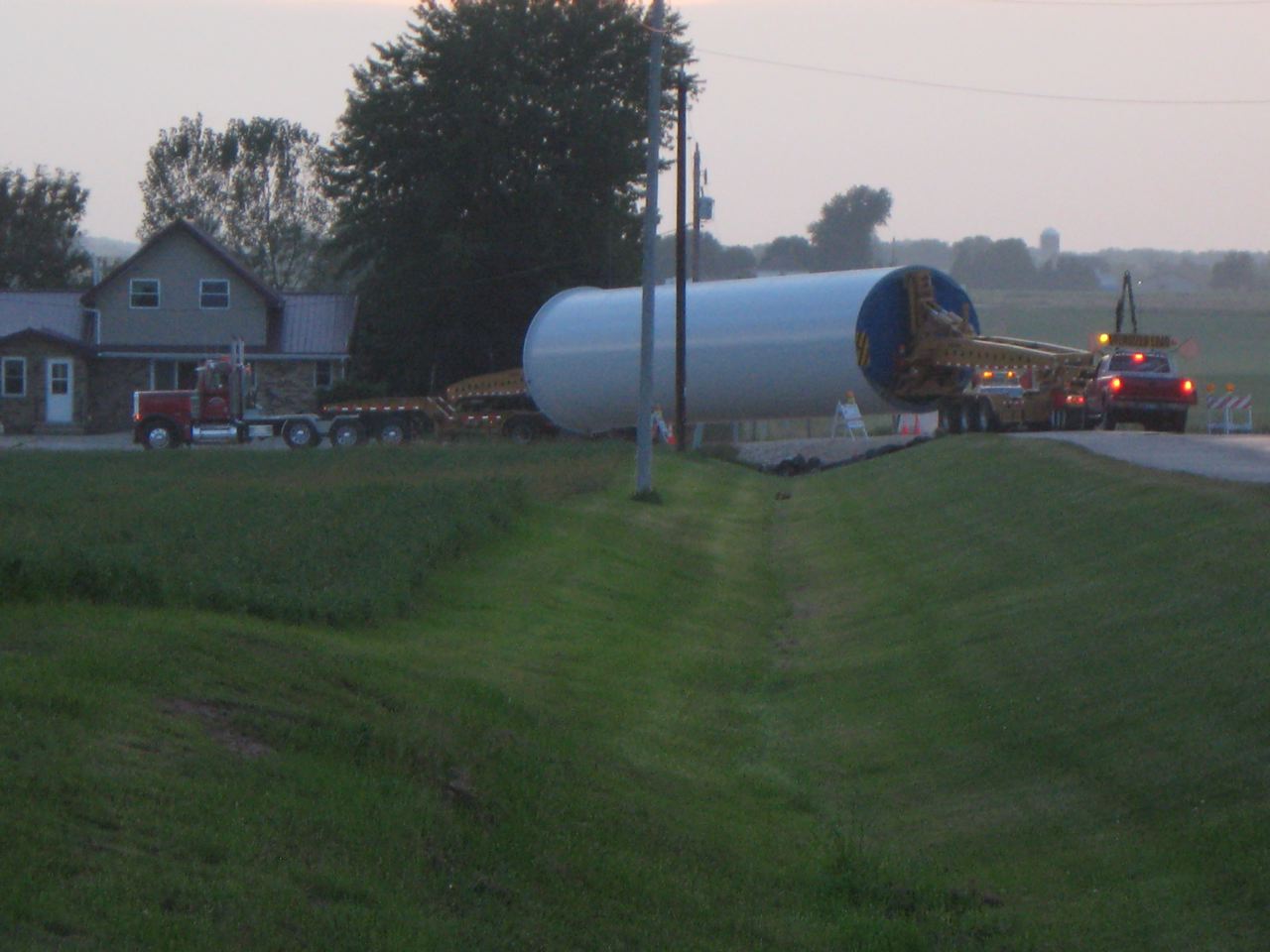
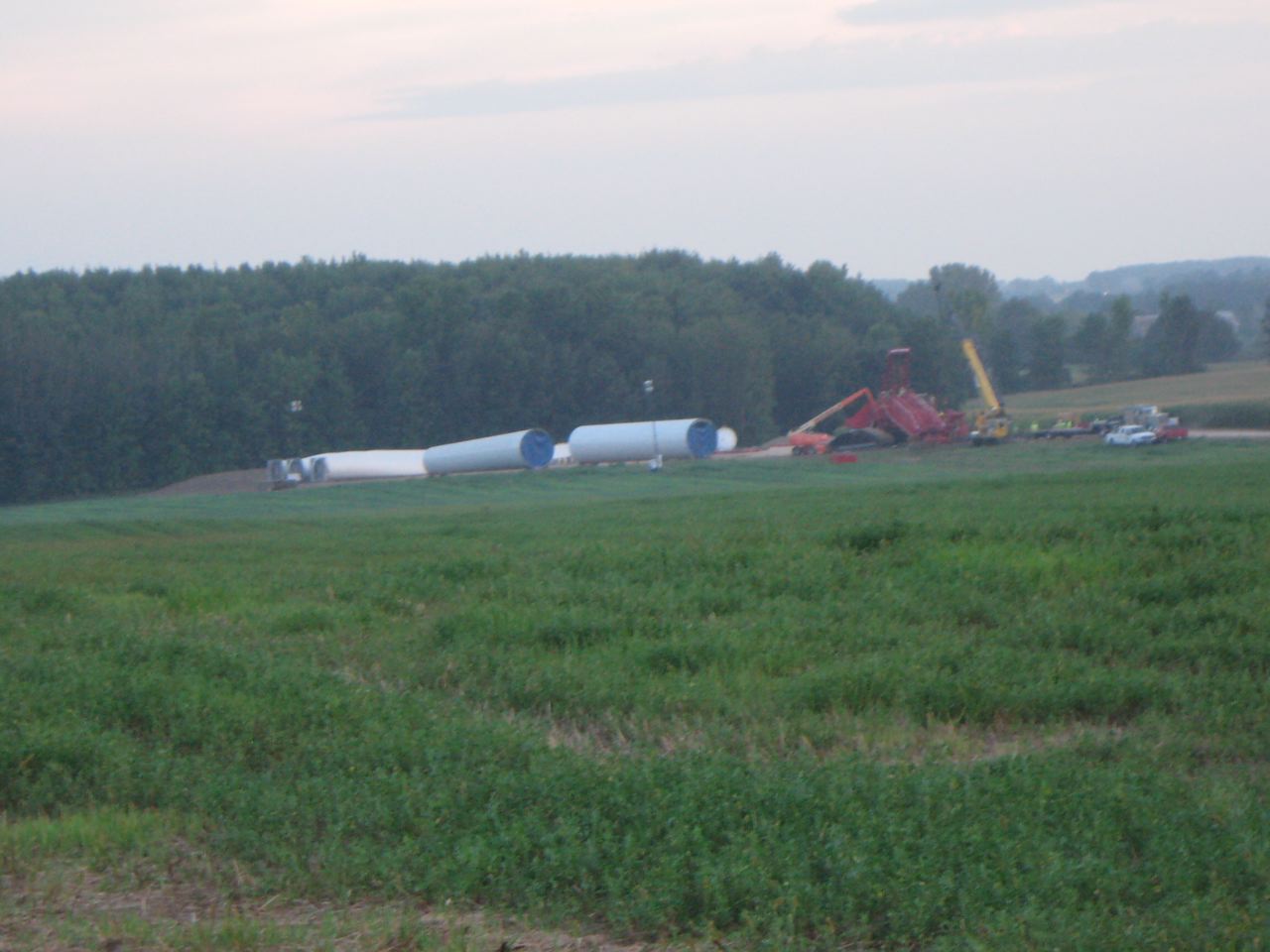 Construction begins on what will be the tallest wind turbines in the state. Town of Glenmore, Brown County Wisconsin. More photos throughout this post.
Construction begins on what will be the tallest wind turbines in the state. Town of Glenmore, Brown County Wisconsin. More photos throughout this post.
Below is A letter from a participating landowner in the Glacier Hills project which is under construction in Columbia County. He address it to Brown County landowners in an area where Invenergy wants to site a large project called "Ledge Wind"
SOURCE: PSC Docket # 9554-CE-100
To the landowners in the Ledge Wind Project:
If you believe wind turbines are a good fit for a farm operation, a free source of clean energy, and a benefit to your community, I invite you to come to the Glacier Hills Project and witness the total devastation occuring during construction.
Seeing firsthand what is happening here would turn any responsible landowner's stomach.
Heavy rains have created erosion that will take years to repair.
The number of huge construction equipment and trucks burning fuel is staggering.
Good productive farmland is being ripped apart, and will never be the same.
The level of disgust is even affecting the most loyal supporters of this project.
Hatred of this project is growing worse as each day passes, and we will be forced to live with this for the rest of our lives, all because a few irresponsible landowners, myself included, were taken in by wind developers lies.
All this for chump change.
Gary Steinich
Cambria, Wisconsin
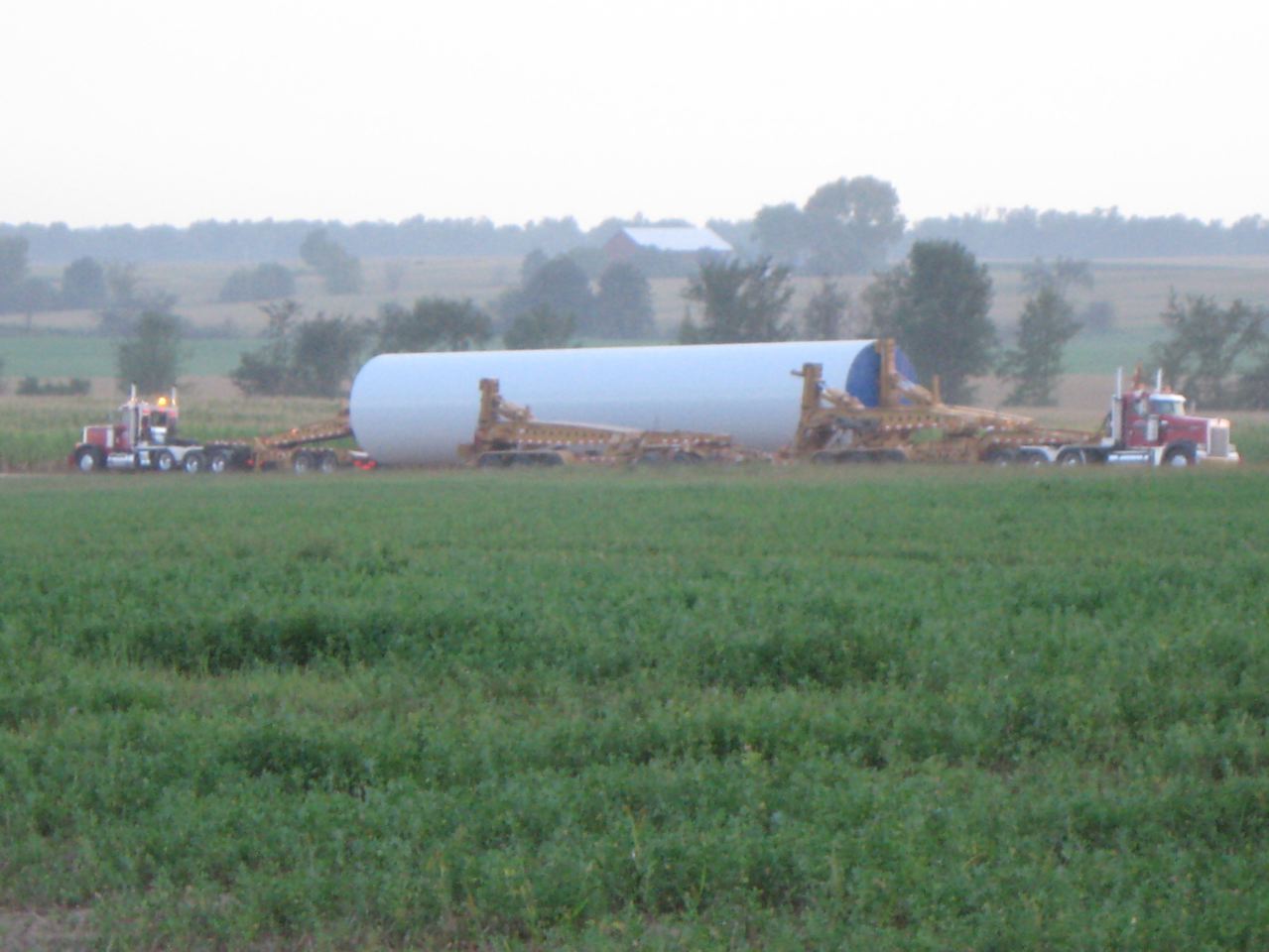
Is wind "farming" compatible with agriculture?
August 25, 2010
We're frequently reminded that wind energy and agriculture are compatible land uses. Farmers who lease sections of their crop land for wind development can continue working the soil right up to the towers and earn extra revenue for farming expenses. A win-win business opportunity, right? Not so fast. In this two-part series, Windaction.org examines the wind-farming relationship in the State of Illinois and tests the claim that the two are a good fit. As with so many topics involving wind energy, there is another story behind the story.
Back in 2007, Windaction.org posted a document entitled "What have I done?" The piece, written by Don Bangart of Chilton, Wisconsin, was based on a two- hour interview he conducted with a farmer in Northeast Fond du Lac County who agreed to lease a portion of his land for wind development. In the interview, the landowner makes several observations including this about how his land was managed:
"I watched stakes being driven in the fields and men using GPS monitors to place markers here and there. When the cats and graders started tearing 22 foot wide roads into my fields, the physical changes started to impact not only me and my family, but unfortunately, my dear friends and neighbors. Later, a 4 foot deep by 2 foot wide trench started diagonally across my field.
"A field already divided by their road was now being divided again by the cables running to a substation. It was now making one large field into 4 smaller, irregularly shaped plots. ...We soon realized that the company places roads and trenches where they will benefit the company most, not the land owner. ... All of the rocks we labored so hard to pick in our youth were replaced in a few hours by miles of roads packed hard with 10 inches of large breaker rock. Costly tiling we installed to improve drainage had now been cut into pieces by company trenching machines."
The Wisconsin farmer's experience is not unique.
Illinois has some of the best farming soil in the world with McLean County, Illinois rated #1 for the darkest, blackest most productive soil in the world.
But after extensive land moving and excavation needed to build roads and erect the turbines, farmers tell Windaction.org that the ground is never the same afterward. The fertile soil around the towers is mixed with subsurface clay and compacted resulting in lower crop yields. Depending on the lease terms, developers may compensate landowners for crop reductions but payments are often not passed on to tenant farmers who suffer the actual losses.
Since compaction is assumed to be a construction-related impact, crop-loss payments are often time-limited up to five years. However, every time turbines require maintenance, the massive crane is brought back to the site making compaction an ongoing concern throughout the life of the project. And it's not limited to existing roads or turbine pads. Turbine maintenance crews prefer to crawl across fields -- flattening crops and ground -- for quicker access to turbines needing service.
If drainage tiles are cut or damaged during construction, you're apt to see farmers working around ponds that were previously nonexistent. Or worse, adjacent fields not under lease can flood. With competition for rentable farmland so fierce, local tenant farmers risk losing their farms if they complain.
Soil compaction and drainage issues are serious concerns, but some might argue their effects are localized, and thus manageable. But that cannot be said about the impact of wind turbines on aerial spraying -- a subject that gets very little exposure.
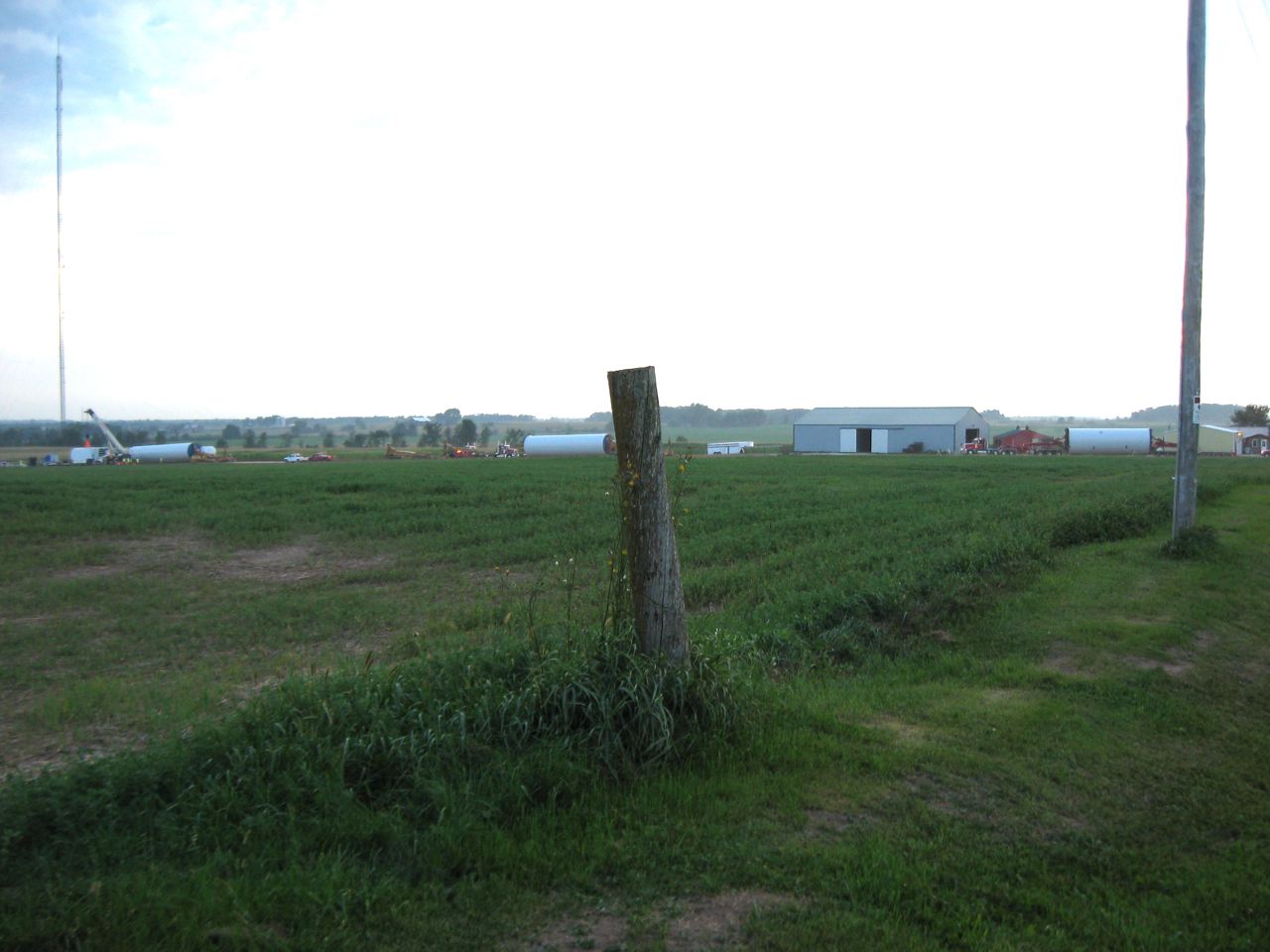
The ability to secure aerial spraying services is limited in areas where turbines are standing.
The message on the Illinois Agricultural Aviation Association (IAAA) website is clear:
"...farmers with wind generators may lose the option of aerial application of farm protection products, seed, fertilizers, etc. on their farm ground. Possibly more significant is that their neighbor farmers, who have no wind generator(s) and consequently no income from them, stand to lose that option as well.
"Some proponents of wind farms tend to dismiss this possibility out of hand, with the explanation that "those guys can fly around them with no problem," or "just get a helicopter to do it." Others say that ground application can still be effectively performed so the aerial option is insignificant. Unfortunately, it is just not that simple. Sometimes weather problems and/or timeliness of application dictate an application from the air.
"The fact is, it is dangerous to fly within the confines of a wind generator farm."
As more and more towers go up, less and less fields can be sprayed. Experienced pilots can feel the wake effect of the towers from several miles away. Such turbulence is dangerous to fly through.
Helicopters may be recommended because they travel at slower speeds and can work in more confined spaces but they can't carry the same loads meaning more trips at higher costs. There are far fewer helicopters in the State (under 10 in total) so timely availability is a critical issue.
Some farmers try ground applicators but aircraft can cover crops faster and more efficiently than any ground rig. In cases of Asian soybean rust, farmers could experience an 80-100% yield loss if not treated within a week. Aphids or spiders mites can destroy a field within days. If infestations occur during wet years ground equipment on wet soil will cause compaction or ruts that lead to erosion.
Illinois County Boards tasked with approving new wind development appear willing to accept that aerial applications are still possible but with more difficulty and at a higher cost (most spray policies charge premiums up to 50% above standard costs on fields within a mile of the towers, whether a participating landowner or not). What they do not seem to realize is that as more wind farms are permitted, the cumulative effect will lead to fewer and fewer fields that can be sprayed, making total crop loss a real possibility.
Since crop insurance will not cover the farmer in cases of insects or plant disease where damage is "due to insufficient or improper application of pest control measures or disease control measures", crop loss could lead to significant financial losses for farmers.
Illinois farm land has nearly 1900 megawatts of wind turbines installed across thousands of acres of farm land and thousands more slated for development. Absentee landowners may be gaining financially from the development, but the idea that "wind farming" is a compatible agriculture use is more myth than reality in Illinois.
Special thanks to Rick Reed, president of IAAA, who provided valuable information on aerial spraying.
Wind Turbines in the News
For the latest national and international wind news visit
News
GREEN PARTY OF CANADA CALLS FOR WIND TURBINE HEALTH STUDY:
Source: Green Party of Canada Website
Considerations:This motion, in calling for a study on the human health effects of wind turbines, would create a new policy and could potentially call into question some of the party's policies on significantly increasing the amount of energy produced through wind turbines.
Motion Preamble:WHEREAS the Green Party of Canada recognizes the vast potential for wind energy in Canada;
WHEREAS the Green Party of Canada with the Canadian Wind Energy Association has set goals for Canadian wind energy generation;
WHEREAS many citizens in communities with wind turbines claim to be experiencing sleep deprivation, headaches, and heart complications related to wind turbines;
WHEREAS one of the largest obstacles preventing accelerated wind energy development is resistance from citizens near planned turbine sites;
WHEREAS the largest investment Canadians make, their home, is affected as much by real health risks as perceived ones;
WHEREAS many provincial governments have compromised their objectivity with respect to wind energy development;
WHEREAS the Green Party of Canada considers healthy people and healthy communities as necessary for a strong Canada;
Motion Operative:THEREFORE BE IT RESOLVED that the Green Party of Canada seeks to have Health Canada initiate an epidemiological study on the human health effects of wind turbines in the interests of public health and safety.
Dong giving up on land-based turbines
Mass protests mean the
energy firm will look offshore
SOURCE: The Copenhagen Post Online
September 1, 2010
State-owned energy firm Dong Energy has given up building more wind farms on Danish land, following protests from residents complaining about the noise the turbines make.
It had been Dong and the government’s plan that 500 large turbines be built on land over the coming 10 years, as part of a large-scale national energy plan. This plan has hit a serious stumbling block, though, due to many protests, and the firm has now given up building any more wind farms on land.
SOURCE, ” On the Level: Quarterly Newsletter of the Vestibular Disorders Association (Summer 2010, p. 9)“Wind Turbines Can Affect Inner Ear Function,
Scientists have determined how infrasound from wind turbines may influence inner ear function.
An increasing number of people living near wind turbines report a group of symptoms termed “wind turbine syndrome” that include sleeplessness, dizziness, fatigue, ear pain and pressure, difficulty concentrating, and headache.
Up until now, many scientists who study hearing claimed that noise from wind turbines couldn’t be harmful because it occurred at a frequency too low for most people to hear.
Researchers at Washington University in St. Louis, Missouri successfully challenged this conventional wisdom that “what you can’t hear won’t hurt you.” They noted that one type of inner-ear sensory cell behaves differently when encountering infrasound.
Usually these cells respond to sound by contracting and expanding proteins within their walls, amplifying vibrations, which in turn stimulate other sensory cells to send electrical signals about sound to the brain. However, the proteins do not respond in the same way to infrasound and instead actively prevent stimulation of the cells that transmit sound signals.
So, while the brain may not receive information about sound, a physiological response to infrasound has occurred in both the cochlea and the other sensory structures in the inner ear such as the saccule, possibly explaining the unfamiliar sensations experienced by some people.
Reference:
Salt AN, Huller TE. “Responses of the ear to low frequency sounds, infrasound and wind turbines.” CLICK HERE TO DOWNLOAD Hearing Research 2010 Sep 1;268(1-2):12-21. Epub 2010 Jun 16.
8/25/10 Wind siting rule talks resume at PSC AND Why is this Canadian doctor recommending longer setbacks? AND what Wisconsin residents are saying about the wind siting rules.
WIND SITING RULE TO BE DISCUSSED BY PSC COMMISSIONERS AT TODAY'S OPEN MEETING
Beginning at 8:00AM
610 North Whitney Way, Madison, Wisconsin
Live audio of the meeting will be broadcast over the web. CLICK HERE to visit the PSC website, click on the button on the left that says "Live Broadcast". Sometimes the meetings don't begin right on time. The broadcasts begin when the meetings do so keep checking back if you don't hear anything at the appointed start time.
MEDICAL OFFICER OF HEALTH BELIEVES WIND TURBINE SETBACKS SHOULD BE LONGER
SOURCE: Lucknow Sentinel, www.lucknowsentinel.com
August 25, 2010
By Sara Bender,
The Grey-Bruce Medical Officer of Health believes the setbacks for wind turbines should be longer.
Dr. Hazel Lynn told Huron-Kinloss Twp. council at the Aug. 16 township meeting that she would recommend longer setbacks for wind turbines. She said she thinks it’s wrong that municipal councils are unable to determine the setbacks.
Lynn said that, within buildings, Low Frequency Noise (LFN) which comes from wind turbines, could cause health affects, such as inner-ear problems. She said those affects would be less if the setbacks were longer than the provincial setback of 550 metres. She added that symptoms are the same around the world but the problem is that not much is known about wind turbines.
“I think we should stop putting (wind turbines) in until we know more about them,” said Lynn, at the council meeting.
The following day, Lynn told an Owen Sound Sun Times reporter that her comments were misquoted from the council meeting on a local radio station. “What I probably said is we should have longer setbacks, and if you can’t have longer setbacks, well, then maybe we shouldn’t be having them (more wind turbine developments) right now.”
She said European research is ahead of that being done in Canada and minimum setbacks there are between 1.2 and 1.5 kilometers. Europeans are concerned about low frequency sound waves, which are amplified in hilly terrain.
“Basically at this point in Canada, we’re not measuring those things. To say that they can’t hear it so it doesn’t affect you isn’t quite true, probably,” she said. “I suggested to Huron-Kinloss that if I was making the decision — which I’m not — and if I was putting in more wind turbines, I’d want them at least a kilometre or a kilometre and a half distance.”
Also, Huron-Kinloss council was asked to participate in a joint meeting with the Municipality of Huron East and any other municipalities affected by proposed wind farms.
Huron East Council received a request to pass regulations controlling development of wind farms and Huron East was asked to create a bylaw regulating LFN. The Huron East Council is hoping to discuss the feasibility of investigating a LFN bylaw or some other forms of regulations with other municipalities.
Coun. Don Murray said Huron East would take the “test” LFN bylaw to a judge to see if it would stand up in court. He added his support to participate in a joint meeting with other municipalities.
“I agree, we should be participating in these meeting. A low frequency noise bylaw could be a benefit to us,” said Coun. Jim Hanna.
Murray agreed to take part in the meetings. He is also representing the municipality on a Windmill Working Group with Arran-Elderslie. At the July council meeting, Murray and Coun. Anne Eadie was appointed as representatives on the working group. However, since that time, Eadie has indicated she can no longer sit on the committee. Mayor Mitch Twolan agreed to sit on the committee in her place.
Meanwhile, township residents continue to express their concern to council with letters about the Bluewater Wind Power Project that could see 50 wind turbines located between Hwy. 21 and Lake Range Drive.
SECOND FEATURE: STRAIGHT FROM THE DOCKET 1-AC-231
Wisconsin residents respond to PSC wind siting rule talks
FROM FOND DU LAC COUNTY:
I have three wind turbines on my property and get $4,000 for each one.
It`s been 2 years now with the turbines and everyone in the community is irritable and short, they snap back. The best of friends for 35 years, but everyone just snaps.
People are not really mad directly at the wind turbines or even know what they are mad about, they`re just mad, aggressive.
The closest one to my house is 3,000 feet away - way too close.
You don't get sleep at night because they roar like at an airport. I get shadow flicker in my house, but down in the village of Johnsburg where those are about another 1,500 feet away from the turbines - oh probably 4,500 feet total those blades are throwing shadows right over all the house roof tops in entire village .....that`s really bad.
All of our tv's got knocked out too. I can only get local channels when the turbine is turned in a certain direction. 97% of the time, we got no reception. There is no mitigation either.
I go to the doctor and now I`m on a lot of different medications. I`ve been to the hospital a couple of times in the past two years with chest pains. And they just can't figure out what it is, but now we`re all being diagnosed with wind turbine syndrome.
And I sure got it.. It definitely causes depression. Memory loss is the worse issue. I see it so bad in myself and especially my parents who are older. But they at the point where they just don`t care anymore because there`s nothing they can do anyhow.
My dad is a totally different person since these things went up. He stays in bed all day now. Even if he does get up to eat, he just goes back to bed. There is no will anymore. I ask the doctor- how are they doing this to us? He just says he doesn't know..
WE energies called today and they are going to be spraying for weeds, so I asked if there were any more plans for windmills? They said, they don't know. I told em... "This area is completely destroyed, it would make more sense to just put a few up around here as opposed to destroying the rest of the state."
I got turbines and the money doesn't pay off in the end. I`ve gotta spend more on cutting around those things and all them cables. It has destroyed my farmland.
I feel really bad for the folks who don`t have contracts cause they`re still all stuck. Even if a realtor wants to sell a place, the first question a buyer asks is if there are windmills in the area. They just hang up.
They should be paying everyone around who is affected, that way - everyone who wants to move could get out and move. So many want to move and leave, but they can't sell their property. The developers deny devaluation, but it`s real... the ones without contracts lost half the value of their property and can't move because they have no money, still tryin to pay off their homes. At least if you got contracts and enough windmills, you can move out.
It turned out to be a real shocker. This whole thing is not right, it should not be done in small communities, but you know, these are just simple country folk who do just don`t say anything. Even if it`s bad, they just go along with it cause what else are they supposed to do?
If I could write out a check from all the money they gave me and give it back, wake up tomorrow morning and all the turbines be gone, that'd be the best thing that ever happened to me.
I affirm that these comments are true and correct to the best of my knowledge and belief.
Allen Haas
Malone, Wisconsin
[We Energies "Blue Sky/Green Field" wind project]
FROM BROWN COUNTY:
To the PSC commissioners,
I think that having a separate day and night noise standard is a mistake and discriminatory.
I have had to work a 3rd shift job during the past two years, and I know a few of my neighbors that have also had to work this shift or a swing shift.
The stated reason that I have seen in the draft for this different day and night standard is that turbine noise may impair the ability of some people to sleep.
Those of us who work during the night and sleep during the day deserve the same stated sleeping protection.
How can a different night and day standard exist if Wisconsin's laws of non-discrimination are to be upheld in your draft rules? I will ask the same question to my representatives at the state level if this is not corrected.
I also would ask that a 3rd party conduct extensive sound studies before and after the installation of a wind farm. What industry conducts its own tests to be in compliance with state laws?
This should not be allowed to take place and invites questionable bias into the sound studies.
I also would like to know the scientific reason for only allowing one sound study to be done every two years if a complaint is made. What is the basis of this rule?
I sincerely hope that commissioners read though the online comments that have been submitted in regards to the rules that you are considering.
After reading the minority report on the submitted draft rules, I have very little faith in the PSC to render a set of rules that is based on current science and the protection of the health and safety of rural tax payers.
Please prove me wrong by considering setbacks that are based on providing safe sitting of wind turbines, and not the monetary concerns of turbine operators.
If fully half of the wind sitting council had a direct financial stake in drafting rules, what else is someone supposed to think of this process. Would the oil companies be allowed to write their own rules?
Please consider a setback distance of at least 2400 feet from people who have not signed contracts for turbines. Let the people who want turbines have them next to their houses with the setbacks that you propose, but please don't risk my sleep, well being, or the ability to sell my home if I have not signed up for a turbine.
I affirm that these comments are true and correct to the best of my knowledge and belief.
Jarret Treu
FROM TOWN OF GREENLEAF:
Thank you for the opportunity to allow me to voice my concerns regarding wind farms in Wisconsin.
I respectfully ask the Commissioners...Do you live in a wind farm? Again, I invite you to take a month retreat to a wind farm and find out first hand what people live with...EVERYDAY and EVERY NIGHT! Research shows a lack of sleep contribrutes to many health risk.
In fact, just a few weeks ago Bellin Health in Green Bay ran a radio campaign promoting their sleep center... the commercial said this... (source bellin.org)
" What`s the price of not sleeping? An extra cup of coffee in the morning to get
going? An occasional night on the couch to give your spouse a break from the snoring? Wrong.
The price of not sleeping is an increased risk of:
Heart disease
Headaches and forgetfulness
Weight gain
Diabetes
Mood changes
Decreased interest in sex
Daytime drowsiness
A higher risk to be in an auto accident
[.....]
9 health issues are listed in this commercial. How many health issues does the PSC need to see in order to WAKE UP and make sure Wisconsin tax payers are protected by wind developers?
Wind development in populated areas is NOT a good idea!
Thank you for your time.
Jackie Flaum
Greenleaf, Wisconsin
FROM TOWN OF MORRISON:
We are residents in the town of Morrison and in the boundaries of the proposed Ledge Wind Project.
We were offered a contract to host up to 3 turbines for this project and we initially thought that it was a great idea. We decided to research this more.
The information we found was too disturbing to proceed with the contract.
If the Ledge Wind project proceeds as it is currently proposed, we will live near 4 turbines.
Below is a list of comments and concerns we have relating to your current discussion on wind energy development. Some of these concerns were also expressed by us when we testified at the Fond du Lac hearings in June.
1. There is no doubt that wind turbines can be noisy. At the very minimum noise limits should be 40 dba from any occupied structure at any time. People don`t sleep only during the night time hours. Practically speaking, we would want no more than 5 dba over ambient. Low frequency noise should also be addressed as that is reported to be even more disturbing.
2. Non-participating landowners should not have to experience any shadow flicker anywhere on their property. Landowners use their land in a variety of ways and at special seasonal times. One should not have to consider if the flicker is present or not to use their property.
3. Due to noise and shadow flicker, setbacks should be at a minimum of 2640 feet, and should be from property lines for non-participating landowners. Most complaints would be eliminated at this distance, thus preventing countless hours of work and expense trying to mitigate and litigate future problems.
4. Land zoned for building homes needs to be considered when setbacks are determined.
5. For our business and personal use, we rely on wireless technology for our Internet; this should be addressed in the signal interference section. Also, we reserve the right to fully use any future technology which may be interfered by the turbines.
6. Wind developers must be required to prove financial assurance at the time of application. In addition, an appropriate renewal bond and/or escrow should be established before construction starts, in the amount equal to the cost of decommissioning each turbine. This must also be able to be levied against the property if need be.
7. It has been proven that the value of property near wind turbines decline. It is common sense that a property with a wind turbine near it will be worth less than the exact same property without a wind turbine. A property value protection clause for non-participating landowners should be signed by the developer at the time of application. Adjacent land owners` investments must be considered and maintained in every instance.
8. Any study done to research the impacts on wildlife, domestic animals, and human health, along with assessing and/or monitoring noise and shadow flicker, must be done by an independent 3rd party who does not have any financial connection with the developer. It is not acceptable for an industry to be allowed to regulate themselves in any way.
9. What is going to happen to all the people currently being negatively impacted by wind turbines? These concerns need to be addressed too. If you look across Europe and now in our country, it is played out similarly in every community where people are within a mile of turbines. Why are we continuing to make the same stupid mistakes as others?
10. Between our son and ourselves, we have investigated 12 different wind turbine companies. Not one of them could show a positive cash flow, even with the heavy subsidies. The most recent conversation we had with a wind turbine developer stated that the "break even" point was at 17 years. However, this did not consider any return investment, return to the landowners or maintenance and decommissioning costs. Wind is not the answer to our energy problems. It will just put us more financially in the hole as a country with only the developers raking off huge profits and minimal compensation to even hosting landowners.
11. We have planning and zoning committees established for years. These are local people who know the community, the lands and the appropriate uses. Our planning and zoning committee, and our town board have adopted 1) a moratorium on industrial wind turbines 2) a setback of 2640 feet and 3) a sound impact of a maximum of 5 dba over ambient. How can you, the PSC, tell us that our desires, needs and requirements are not as valued as what you think? We know what is best for where we live!
There are simply too many variables relating to wind energy in Wisconsin. Instead of moving ahead blindly, proper, independent studies need to be completed to determine the impacts of wind turbines.
Sincerely,
Jon and Lori Morehouse
FROM CALUMET COUNTY
As a member of the Calumet County Ad Hoc Committee and the Townships of Chilton's Wind Advisory Committee I feel it is very important the the PSC makes sure it does things correctly.
I spent over 6 months in study while working on these committees as well as over 4 years on the issue at hand.
The other main issue that we tried to work with is the issue of shadow flicker.
Sound was the Major issue but in many cases the issue of Shadow Flicker caused as much or more problems for people who lived near the Industrial Wind Turbine sites.
In my studies the shadow flicker caused head aches and health problems due to the constant flickering that could not and can not be blocked out with shades or plantings.
A time period of 40 hrs per year is way too much time and often the modeling that the Wind Industry uses in incorrect and once the Turbine is built they do not move it they only have to mitigate or reduce the problem.
What does that [mean for] me? It means only [they only have to ]try and make it less bad! The problem still exists. So shadow Flicker should not be allowed for a period of greater than 90 seconds of any day within a hundred feet of a sensitive receptor not just on the sensitive receptor ['s home]. People work in their yards etc. So they should be protected there also. The shadow flicker causes nausea and dizziness -my own family has had the experience.
So make them place the turbines correctly the first time they do not move them once they are up. If the setback of 2,200 feet is used for sound this will also reduce the issue of the shadow flicker.
I affirm that these comments are true and correct to the best of my knowledge and belief.
Daniel W Hedrich
FROM MANITOWOC COUNTY:
Hello,
I am a Supervisor with the Town of Mishicot, in Manitowoc County. I have a few comments for you to consider while drafting wind turbine rules.
We need to protect residents from negative issues connected with wind turbines. We have to develop a process that gives residents the upper hand to resolve legitimate complaints from windturbines quickly. Wind farm owners should in no way be handling the enforcement of regulations or be in charge of the resolution process.
Having proper setbacks from turbines for things such as noise would adress issues up front, making enforcement and problem resolution a far less common situation in a wind farm.
Low frequency noise has to be addressed.
Places where farm animals as well as humans habitate need to be protected.
We should not be taking property rights of non-participating land owners.
TV and radio signal interference problems need to be resolved quickly, fully, and without cost to residents.
Emergency signals and corridors need to be protected.
Towns need the ability to protect their roads and have damage repaired by the developer with no cost to the Town.
I've been following this issue for 6 years and at times have been fully disgusted at the way the State of Wisconsin has handled things.
From taking away local control, to setting up a heavily weighted pro wind committee to establish guidelines for turbines.
Myself and others see our property and wind rights over our lands being taken, allowing windfarm developers to dictate to us what we can do with our lands and casting unsafe zones over our properties limiting how we can develop it.
We are losing rights we currently have and the State seems all so happy to do it. We are promoting something that will never provide economical baseload power, and in my area, where there are nuclear plants, the proposed wind farm may very well use up the remaining capacity of the local grid (even though much of the time turbines won't be producing electricity) thus eliminating the addition of new reactors without spending millions of dollars to upgrade the grid.
I expect the health and safety and rights of residents to be protected. I ask that you take the time to create a set of rules that properly address the issues.
Sincerely,
Dean Anhalt
MORE FROM MANITOWOC COUNTY
I would like to address a few additional concerns with the wind siting rules.
1) It was my understanding the siting council was supposed to review the existing wind energy ordinances in the state. This was never discussed at the meetings.
Towns and Counties spent years working on these ordinances, which is far more than the 5 months the siting council was allowed. These ordinances were written after doing a great amount of research without allowing influence by the financially motivated.
2) Act 40 and statute 66.0401 clearly state that rules can be set to protect health and safety regardless if those rules increase the cost of the system, yet when the council discussed setbacks and noise limits, the discussion always led to the increased cost of the system.
Health and safety must be considered before profits and politics.
3) Turbine companies recommend using relative rather than fixed noise limits, the majority of the council voted against this. I believe 5dba over ambient is the fair way to go. There was a great amount of research submitted to the docket that supports this limit.
I also feel a ½ mile setback would be more appropriate. Many documents submitted to the docket support this, and even greater setbacks, up to 1-2 miles. Other countries have started with shorter setbacks and have realized they are not adequate and are now using much larger ones. Please, use their mistakes as a learning curve and do not repeat them.
4) Please use a 3rd party for all testing required as well as the computer modeling for siting purposes. Wind energy reps are still lying to landowners, telling them that there are no negative health effects from the turbines.
As members of the PSC, you have acknowledged that there are negative health effects and are struggling with how to write rules to deal with these issues.
If the developers are lying to landowners when trying to get them to host turbines, and then including gag orders in the lease contracts preventing them from complaining about any negative effects that they say do not exist, what else are they lying about?
We can’t allow this industry to self-test in any way. The wind industry is not regulated and must be overseen, especially when their actions can have such a serious negative effect on health and safety of our good Wisconsin families.
We already have too many non-participating families that are suffering and have no recourse because the developer is “within” the limits that were set by the PSC or they signed away their rights in a contract with a gag order.
Act 40 clearly states, “The subject matter of these rules shall include setback requirements that provide reasonable protection from any health effects, including health effects from noise and shadow flicker, associated with wind energy systems”.
Two years ago, energy committees in the house and the senate listened to testimony related to Senate Bill 185. The proposed bill was asking that the PSC be given state wide control to promulgate rules establishing common standards for political subdivisions to regulate the construction and operation of wind energy systems.
While the proposed bill stated “rules must specify the restrictions a political subdivision may impose on the installation or use of such a system, and may include subjects such as visual appearance, setback distances, decommissioning, shadow flicker, electrical connections to the power grid, and interference with radio telephone, or television signals”,
Act 40, the passed bill, clearly has changed may to shall and added “The subject matter of these rules shall include setback requirements that provide reasonable protection from any health effects, including health effects from noise and shadow flicker, associated with wind energy systems”.
It is clear the original intent of the bill was to take away the “patchwork” effect of local control, and the legislature did make the decision to do so. But they also clearly chose to add amendments to the original bill, and made it clear in ACT 40 that the siting council and the PSC shall create rules for reasonable protection from any health effects, including those from noise and shadow flicker.
It seems, according to state statute, that our legislators have already determined that health effects from noise and shadow flicker do exist and are directing this council and the PSC to set reasonable rules to protect the public.
Dr. McFadden has determined that after reviewing the information that there is not sufficient evidence showing there are negative health effects directly related to wind turbines. Chairman Ebert also stated according to his beliefs and feelings, he agrees with Dr. McFadden.
It appears that it is not the decision of this council or the PSC to make whether or not there are health effects but to determine what rules are reasonable to protect against them.
The energy committees and the legislature would not have added that specific element to the statute unless they determined, after public hearings in 2008, that the existing rules were insufficient to address the health and safety concerns brought forth by the public.
Act 40 also states: “The wind siting council shall survey the peer−reviewed scientific research regarding the health impacts of wind energy systems and study state and national regulatory developments regarding the siting of wind energy systems.
No later than the first day of the 60th month beginning after the effective date of this paragraph ....[LRB inserts date], and every 5 years thereafter, the wind siting council shall submit a report to the chief clerk of each house of the legislature, for distribution to the appropriate standing committees under s. 13.172 (3), describing the research and regulatory developments and including any recommendations of the council for legislation that is based on the research and regulatory developments”.
I do not see anywhere that it directs these bodies to look at only peer-reviewed research. It states that they shall survey the peer-reviewed scientific research, but nowhere does it limit us or prohibit from looking at other material, including surveying those already self-reporting the negative health effects of living in a wind farm.
I suggest that we conduct an independent survey of those people that are already suffering the negative effects before this council proceeds any further. We need to figure out what was done wrong with the existing wind farms before we go installing more and allowing more families to become collateral damage. This is something that should have been done the day the turbines began spinning in the existing wind farms. There would have been actual data to study.
Act 40 also does not direct us to set rules to make sure wind turbines are sited in the state. It does however distinctly direct this council to set rules that provides reasonable protection from any health effects. It does not state unless those restrictions eliminate some wind turbine sites.
State statute clearly states that only one of the following be met: To preserve or protect the public health or safety, or where the restriction does not significantly increase the cost of the system or significantly decrease its efficiency, or where the locality allows for an alternative system of comparable cost and efficiency.
One thing that has been lacking in the debate is what to do with those poor families already suffering.
Consider it a “recall” on a bad product. The State of Wisconsin needs to do two things. Prevent this debacle from ever happening to anyone else residing in the State of Wisconsin and they seriously look at what they need to do to assist and compensate those families already suffering from the negligent siting of industrial wind turbines.
The way their lives have been ruined is a travesty. Common Sense tells us that reasonable protection would not be using the same standards as were used in the existing wind farms, which was recommended by the financially motivated majority of the wind siting council.
Please be reasonable and set rules that will protect us as your mission statements expresses; We consider and balance diverse perspectives and we endeavor to protect the environment, and the public interest and the public health and welfare.
As Act 40 clearly does not designate to the PSC a time frame for promulgating the rules, so we definitely have more than enough time to give this the attention it distinctly deserves.
The following is transcribed from Dr. McFadden’s (who also suggested a 40dba limit) comments at the June 2nd meeting and I feel is quite important to address:
“From a health stand point we can’t come up with a figure that is in the best interest of the people of Wisconsin, unfortunately the legislature singled out health and safety.
At least based on the admittedly not great literature that’s available on this issue, health and safety are not a primary concern with the setbacks we have been using.
However, there are many other issues which are reasonable concerns. Issues of annoyance are things that we have to take into account. Such as WHO defines annoyance as an adverse health effect, but at the CDC and our health department that’s not something we use as our threshold for when we intervene. But I do think we have to take that into account.
So the only thing I have to go on, I reviewed the literature, the only number that jumps out and the studies of the Swedish and the Netherlands, they did show a statistically significant increase in self reported sleep disturbance beginning at 45dba.
That is not great data but it is the best we have to go on. It is not the quality of research that you would like to base decisions on necessarily, but furthermore self reported sleep disturbance is a highly subjective outcome. But never the less if we’re trying to look at the literature and base decisions on that, that’s probably the best marker that we have.
Annoyance from shadow flicker again is a real concern.
I don’t know that that’s been quantified sufficiently to say that people who are exposed to shadow flicker 25 hours a year are annoyed and those that are exposed less are not annoyed.
I don’t know that there is a specific number, maybe Andy or others would be privy to that sort of information. I think at some point we have to come to a determination to what is an acceptable level of annoyance just as we do with all development projects and try to keep annoyance, property values or other impacts, try to at least put them on the same page as health issues."
I beg you to set rules that will protect us from any and all negative effects. Please keep in mind that wind is not the only renewable and consider other forms of renewable for highly populated rural areas. I would reference the E4 initiative started by Senator Feingold. There are so many families that could benefit tremendously from assistance with improving the energy efficiency of their homes, which would reduce their utility costs rather than increase it, as will happen with the high cost of wind energy.
The PSC vows to be a leader in the state and in the nation by facilitating, promoting and ensuring the availability of affordable, reliable, environmentally sound and safe utility services. Please be true to that promise and set rules to insure our safety and promote renewable energy for our rural areas that will save us money not cost us more.
I truly appreciate the opportunity to submit comments. This is an issue that we are deeply concerned about as it will affect us in a very big way. It has been life changing in a very bad way to so many and the rest of us are scared as we have seen personally what can happen. It was at first stories on the computer about those affected, now we have visited and met these people personally, which is deeply depressing to say the least.
Lynn Korinek
Mishicot, WI 54228
PSC REF#:137298
Public Service Commission of Wisconsin
RECEIVED: 08/24/10, 7:31:36 PM
FROM WISCONSIN DIVISION OF AGRICULTURE, TRADE, AND CONSUMER PROTECTION (DATCP)
DATCP is concerned about the impact of wind turbines on vegetable production in Wisconsin. Aerial applicators have stated that it is not safe to aerially apply within one-half mile of wind turbines because they are a barrier to safe application and create a wind wake that can be dangerous to the pilot.
Vegetable production relies heavily on aerial applications of plant protection products in order to ensure yield and quality products. Multiple aerial applications on high-value vegetable crops are often required and must be applied quickly after a pest problem or disease is identified. Under wet conditions, aerial application is the only alternative.
Locating wind turbines in intense vegetable production areas exposes these fields to significant risk of crop revenue loss. It affects not only the growers, but the vegetable processors that depend on reliable production and quality levels to run their processing facilities efficiently. Processing facilities are often located near areas of intense vegetable production and are a significant employer in the local economies.
Aerial application of pesticides on vegetables is concentrated in limited areas of Wisconsin. In general, these are areas not identified as having good wind production potential.
The Council Draft Rule version 1.0 dated 4-13-10 included a provision that allowed a political subdivision to require a developer, owner or operator to provide compensation to farm operators on nonparticipating properties within an unspecified distance from a wind turbine site for reductions in crop production or increased application costs due to the wind energy system`s effect on aerial spraying.
The Commission has not included this provision in the most recent draft because it would be difficult to administer. DATCP has been working with UW-Madison on methods to assess these crop loses and believes that a workable process can be established that would provide justifiable compensation.
The rule could allow for a compensation mechanism without specifying the details needed to implement it. This would be similar to Wis. Stats. s. 182.017 (7)(b), which allows compensation for damages when land is rendered less accessible to farm implements and aircraft used in crop production as a result of locating transmission lines and associated facilities. The statute does not specify the process through which compensation for damages is determined, simply that it is allowed.
Thank you for considering our comments.
8/21/10 When it comes to safety concerns regarding Big Wind, are conclusions based on Sound Science or "Sound's good"?
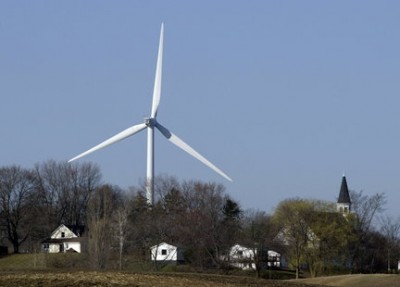 Wind turbines bring a big change to small midwestern towns.NOTE FROM THE BPWI RESEARCH NERD: Dr. Douglas Zweizig, who authored this letter to the Wisconsin State Journal is Professor Emeritus of Library Sciences and Information, University of Wisconsin. He also serves as Planning Commissioner for the Town of Union in Rock County and is on the Wisconsin Wind Siting Council which has spent several months reviewing data and creating wind siting rules for our state.
Wind turbines bring a big change to small midwestern towns.NOTE FROM THE BPWI RESEARCH NERD: Dr. Douglas Zweizig, who authored this letter to the Wisconsin State Journal is Professor Emeritus of Library Sciences and Information, University of Wisconsin. He also serves as Planning Commissioner for the Town of Union in Rock County and is on the Wisconsin Wind Siting Council which has spent several months reviewing data and creating wind siting rules for our state.
Journal, health agency wrong about turbines
Wisconsin State Journal, madison.com 21 August 2010
The State Journal’s editorial Wednesday, “Science says wind power safe,” provides false reassurance to its readers about the dangers of living in the vicinity of large wind turbines.
The “science” trumpeted in your editorial comes from an inadequate literature review conducted by under-qualified staff at the Wisconsin Division of Public Health — a staff that has not conducted a survey of the hundreds of people in Wisconsin now living in the vicinity of large wind turbines. They have not spent one overnight in a wind farm, the time when the most troublesome noise occurs.
Instead of caring for the difficulties of Wisconsin citizens and directly addressing the numerous complaints of sleeplessness and the ailments that result from disturbed sleep, the division has instead prepared a report from its undiscerning reading of the literature. It has told those suffering these effects that they have no complaint, and then the division has promoted this callous position to the press.
Wisconsin deserves better care from its Department of Health Services.
— Douglas Zweizig, Evansville

